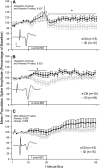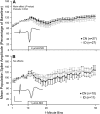Perinatal nutritional iron deficiency impairs noradrenergic-mediated synaptic efficacy in the CA1 area of rat hippocampus
- PMID: 20089786
- PMCID: PMC2821889
- DOI: 10.3945/jn.109.114702
Perinatal nutritional iron deficiency impairs noradrenergic-mediated synaptic efficacy in the CA1 area of rat hippocampus
Abstract
Many studies have shown that perinatal nutritional iron deficiency (ID) produces learning impairments in children. Research has also shown that catecholamines like epinephrine and norepinephrine play a pivotal role in the consolidation of memories. In this study, we sought to determine if perinatal ID impairs the following: 1) noradrenergic synaptic function in the hippocampus; and 2) several forms of hippocampus-dependent fear learning. Electrophysiological brain slice methods were used to examine noradrenergic-mediated synaptic efficacy in the CA1-hippocampus of rats that were subjected to perinatal ID or control (CN) diets. Rats were fed ID (3 mg Fe/kg) or CN (45 mg Fe/kg) diets on gestational d 14. These diets were maintained until postnatal d (P) 12 after which all rats were switched to the CN diet. Hippocampal slices were prepared between P26 and P30. The noradrenergic agonist isoproterenol (ISO) (1, 2, or 4 micromol) was used to induce modulatory increases in synaptic efficacy in the hippocampal slices. CN slices showed a long-lasting increase in synaptic efficacy as the result of ISO perfusion in the slice bath, whereas ID slices did not show increases in synaptic efficacy as the result of ISO perfusion. ID and CN groups did not differ when ISO was perfused through slices from adult rats (P61). Both young and adult ID rats showed reduced levels of hippocampus-dependent fear learning compared with the young and adult CN rats. Together, these findings suggest that ID may impair early forms of noradrenergic-mediated synaptic plasticity, which may in turn play a role in adult learning deficits.
Figures



Similar articles
-
Postnatal nutritional iron deficiency impairs dopaminergic-mediated synaptic plasticity in the CA1 area of the hippocampus.Nutr Neurosci. 2015 Aug;18(6):241-7. doi: 10.1179/1476830514Y.0000000121. Epub 2014 Mar 28. Nutr Neurosci. 2015. PMID: 24678581
-
Perinatal nutritional iron deficiency reduces hippocampal synaptic transmission but does not impair short- or long-term synaptic plasticity.Nutr Neurosci. 2005 Oct-Dec;8(5-6):277-85. doi: 10.1080/10284150500499644. Nutr Neurosci. 2005. PMID: 16669598
-
Fetal iron deficiency disrupts the maturation of synaptic function and efficacy in area CA1 of the developing rat hippocampus.Hippocampus. 2005;15(8):1094-102. doi: 10.1002/hipo.20128. Hippocampus. 2005. PMID: 16187331
-
Perinatal nutritional iron deficiency impairs hippocampus-dependent trace eyeblink conditioning in rats.Dev Neurosci. 2008;30(4):243-54. doi: 10.1159/000110502. Epub 2007 Oct 26. Dev Neurosci. 2008. PMID: 17962715
-
The role of iron in learning and memory.Adv Nutr. 2011 Mar;2(2):112-21. doi: 10.3945/an.110.000190. Epub 2011 Mar 10. Adv Nutr. 2011. PMID: 22332040 Free PMC article. Review.
Cited by
-
Iron deficiency with or without anemia impairs prepulse inhibition of the startle reflex.Hippocampus. 2013 Oct;23(10):952-62. doi: 10.1002/hipo.22151. Epub 2013 Jul 8. Hippocampus. 2013. PMID: 23733517 Free PMC article.
-
Research review: maternal prenatal distress and poor nutrition - mutually influencing risk factors affecting infant neurocognitive development.J Child Psychol Psychiatry. 2013 Feb;54(2):115-30. doi: 10.1111/jcpp.12000. Epub 2012 Oct 5. J Child Psychol Psychiatry. 2013. PMID: 23039359 Free PMC article. Review.
-
Prenatal Choline Supplementation Diminishes Early-Life Iron Deficiency-Induced Reprogramming of Molecular Networks Associated with Behavioral Abnormalities in the Adult Rat Hippocampus.J Nutr. 2016 Mar;146(3):484-93. doi: 10.3945/jn.115.227561. Epub 2016 Feb 10. J Nutr. 2016. PMID: 26865644 Free PMC article.
-
Fetal and neonatal iron deficiency reduces thyroid hormone-responsive gene mRNA levels in the neonatal rat hippocampus and cerebral cortex.Endocrinology. 2012 Nov;153(11):5668-80. doi: 10.1210/en.2012-1067. Epub 2012 Oct 9. Endocrinology. 2012. PMID: 23054056 Free PMC article.
-
Prevention and schizophrenia--the role of dietary factors.Schizophr Bull. 2011 Mar;37(2):272-83. doi: 10.1093/schbul/sbq121. Epub 2010 Oct 25. Schizophr Bull. 2011. PMID: 20974747 Free PMC article.
References
-
- Lozoff B, Jimenez E, Wolf AW. Long-term developmental outcome of infants with iron deficiency. N Engl J Med. 1991;325:687–94. - PubMed
-
- Lozoff B, Wolf AW, Jimenez E. Iron-deficiency anemia and infant development: effects of extended oral iron therapy. J Pediatr. 1996;129:382–9. - PubMed
-
- McEchron MD, Cheng AY, Liu H, Connor JR, Gilmartin MR. Perinatal nutritional iron deficiency permanently impairs hippocampus-dependent fear learning. Nutr Neurosci. 2005;8:195–206. - PubMed
-
- McEchron MD, Alexander DN, Gilmartin MR, Paronish MD. Perinatal nutritional iron deficiency impairs hippocampus-dependent trace eyeblink conditioning in rats. Dev Neurosci. 2008;30:243–54. - PubMed
-
- McEchron MD, Paronish MP. Perinatal nutritional iron deficiency reduces hippocampal synaptic transmission but does not impair short- or long-term synaptic plasticity. Nutr Neurosci. 2005;8:277–85. - PubMed
Publication types
MeSH terms
Substances
Grants and funding
LinkOut - more resources
Full Text Sources
Miscellaneous

